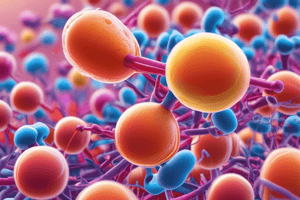Podcast
Questions and Answers
Which tetracyclines achieve therapeutic levels in the cerebrospinal fluid?
Which tetracyclines achieve therapeutic levels in the cerebrospinal fluid?
- Tetracycline and doxycycline
- Minocycline and tetracycline
- All tetracyclines
- Doxycycline and minocycline (correct)
What is the primary route of elimination for doxycycline?
What is the primary route of elimination for doxycycline?
- Bile into the feces (correct)
- Hepatic metabolism
- Sweat
- Urine
Which of the following body fluids has inadequate penetration of tetracyclines?
Which of the following body fluids has inadequate penetration of tetracyclines?
- Most body fluids
- Cerebrospinal fluid (correct)
- Tears
- Saliva
What is the reason for noncompliance with tetracyclines?
What is the reason for noncompliance with tetracyclines?
Which of the following is a unique characteristic of minocycline?
Which of the following is a unique characteristic of minocycline?
Why is doxycycline preferred in patients with renal dysfunction?
Why is doxycycline preferred in patients with renal dysfunction?
What is the reason behind the toxic effects of high concentrations of chloramphenicol or tetracyclines?
What is the reason behind the toxic effects of high concentrations of chloramphenicol or tetracyclines?
What is the unique feature of the transport mechanism of tetracyclines in susceptible organisms?
What is the unique feature of the transport mechanism of tetracyclines in susceptible organisms?
Where do tetracyclines concentrate in susceptible organisms?
Where do tetracyclines concentrate in susceptible organisms?
What is the mechanism of action of tetracyclines in inhibiting protein synthesis?
What is the mechanism of action of tetracyclines in inhibiting protein synthesis?
What is the characteristic feature of the structure of tetracyclines?
What is the characteristic feature of the structure of tetracyclines?
What is the effect of substitutions on the rings of tetracyclines?
What is the effect of substitutions on the rings of tetracyclines?
What percentage of parenteral aminoglycosides are excreted unchanged in the urine?
What percentage of parenteral aminoglycosides are excreted unchanged in the urine?
In which bodily fluids do aminoglycosides penetrate variably?
In which bodily fluids do aminoglycosides penetrate variably?
What is the primary route of excretion for neomycin?
What is the primary route of excretion for neomycin?
Why is therapeutic drug monitoring necessary for aminoglycosides?
Why is therapeutic drug monitoring necessary for aminoglycosides?
What is the primary risk factor for ototoxicity and nephrotoxicity?
What is the primary risk factor for ototoxicity and nephrotoxicity?
Where do aminoglycosides accumulate in the inner ear?
Where do aminoglycosides accumulate in the inner ear?
Where are erythromycin and its metabolites excreted?
Where are erythromycin and its metabolites excreted?
What is the most common adverse effect of macrolides?
What is the most common adverse effect of macrolides?
Why should the dosage of clarithromycin be adjusted in some patients?
Why should the dosage of clarithromycin be adjusted in some patients?
What is a rare effect of high doses of erythromycin?
What is a rare effect of high doses of erythromycin?
Which macrolide is associated with irreversible sensorineural hearing loss?
Which macrolide is associated with irreversible sensorineural hearing loss?
What is the excretion pathway of clarithromycin and its metabolites?
What is the excretion pathway of clarithromycin and its metabolites?
What is the mechanism of anemia associated with glucose-6-phosphate dehydrogenase deficiency?
What is the mechanism of anemia associated with glucose-6-phosphate dehydrogenase deficiency?
Why are neonates more susceptible to the adverse effects of chloramphenicol?
Why are neonates more susceptible to the adverse effects of chloramphenicol?
What is the effect of chloramphenicol on the metabolism of warfarin and phenytoin?
What is the effect of chloramphenicol on the metabolism of warfarin and phenytoin?
What is the mechanism of action of clindamycin?
What is the mechanism of action of clindamycin?
What type of organisms is clindamycin primarily used to treat?
What type of organisms is clindamycin primarily used to treat?
What is the relationship between clindamycin and erythromycin resistance?
What is the relationship between clindamycin and erythromycin resistance?
What is the primary site of metabolism for quinupristin and dalfopristin?
What is the primary site of metabolism for quinupristin and dalfopristin?
What is the result of quinupristin/dalfopristin's competition with the antibiotic for excretion?
What is the result of quinupristin/dalfopristin's competition with the antibiotic for excretion?
What is the mechanism of action of oxazolidinones?
What is the mechanism of action of oxazolidinones?
What is the antibacterial spectrum of oxazolidinones primarily directed against?
What is the antibacterial spectrum of oxazolidinones primarily directed against?
What is the effect of quinupristin/dalfopristin on cytochrome P450 CYP3A4 isoenzyme?
What is the effect of quinupristin/dalfopristin on cytochrome P450 CYP3A4 isoenzyme?
What is the primary excretion pathway of quinupristin and dalfopristin?
What is the primary excretion pathway of quinupristin and dalfopristin?
What is the result of administering quinupristin/dalfopristin through a peripheral rather than a central line?
What is the result of administering quinupristin/dalfopristin through a peripheral rather than a central line?
What is the effect of higher doses of quinupristin/dalfopristin?
What is the effect of higher doses of quinupristin/dalfopristin?
What is the antibacterial activity of oxazolidinones against Mycobacterium tuberculosis?
What is the antibacterial activity of oxazolidinones against Mycobacterium tuberculosis?
Flashcards are hidden until you start studying




